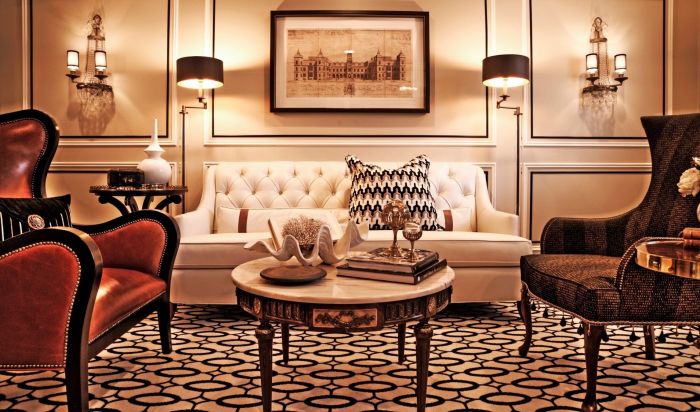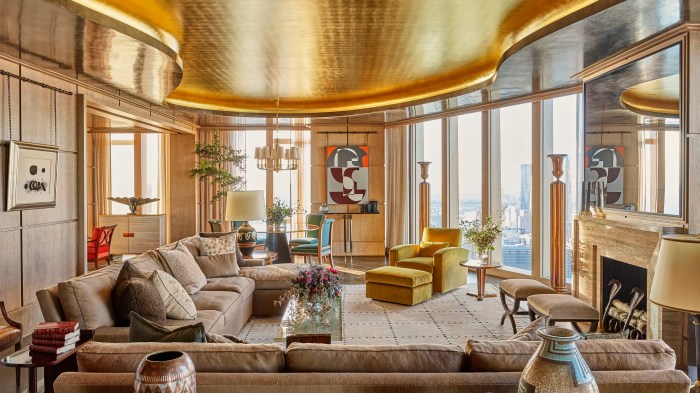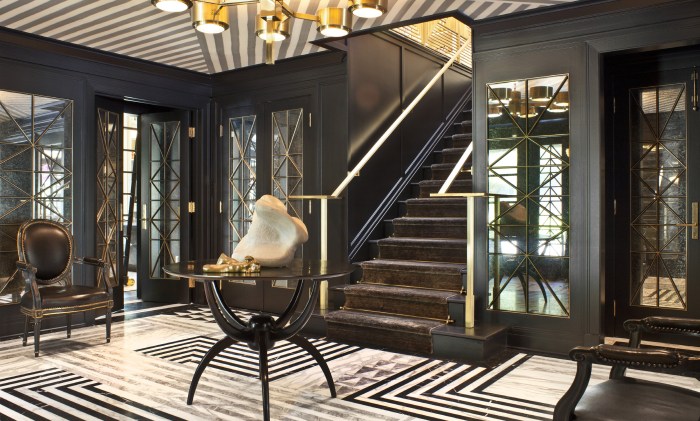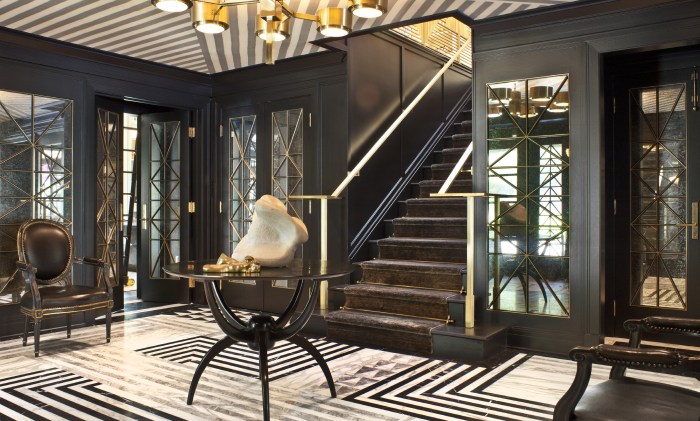Art Deco house interior design, a style born in the roaring twenties, continues to captivate with its bold geometric patterns, luxurious materials, and elegant sophistication. This design movement, influenced by modernism and the exoticism of the East, celebrates the glamour and innovation of the era.
Stepping into an Art Deco home is like stepping into a time capsule, where streamlined forms, contrasting materials, and rich jewel tones create a captivating atmosphere.
The signature elements of Art Deco interiors include geometric patterns, like zigzags and sunbursts, often found in wallpaper, textiles, and furniture. The use of luxurious materials, such as polished chrome, exotic woods, and lacquered surfaces, adds a touch of opulence.
The color palette is equally striking, featuring rich jewel tones like emerald green, sapphire blue, and ruby red, often accented with metallic finishes and black and white contrasts. This combination of geometric patterns, luxurious materials, and bold colors creates a truly unique and timeless aesthetic.
Decorative Elements and Accessories

Art Deco interiors are known for their luxurious and sophisticated use of decorative elements. These elements, often inspired by exoticism and the glamour of the “Roaring Twenties,” add a touch of opulence and visual interest to the space.
Use of Decorative Elements
Decorative elements in Art Deco interiors serve both aesthetic and functional purposes. They create visual focal points, enhance the overall design scheme, and reflect the homeowner’s personal style. Common decorative elements include:
- Sculptures: Abstract or stylized sculptures, often made of bronze, marble, or wood, were popular choices. They were typically placed on mantelpieces, side tables, or pedestals to add a touch of artistic flair.
- Vases: Geometrically-shaped vases, often made of glass, ceramic, or metal, were used to display flowers or other decorative elements. These vases were often adorned with intricate patterns or motifs, adding a sense of sophistication to the space.
- Mirrors: Large, ornate mirrors with geometric frames or sunburst designs were essential for creating a sense of spaciousness and reflecting light. Mirrors were strategically placed to enhance the room’s dimensions and add a touch of glamour.
- Artwork: Art Deco interiors often featured bold and geometric paintings, prints, or photographs. These pieces were chosen for their vibrant colors, dynamic compositions, and subject matter that reflected the era’s fascination with modernism and technology.
Influence of Exoticism and the “Roaring Twenties”, Art deco house interior design
The “Roaring Twenties” was a period of unprecedented prosperity and social change, marked by a fascination with exotic cultures and the rise of modernism. This influence is evident in Art Deco decorative accessories, which often incorporated elements from cultures like Egypt, China, and Japan.
- Egyptian motifs: Hieroglyphics, stylized figures, and geometric patterns inspired by ancient Egyptian art were popular decorative elements. These motifs were often found on furniture, rugs, and wall coverings.
- Chinese and Japanese influences: Art Deco designers incorporated elements of Chinese and Japanese art, such as stylized dragons, bamboo motifs, and geometric patterns, into their designs. These influences were particularly evident in ceramics, textiles, and lacquerware.
- “Roaring Twenties” glamour: Decorative accessories often reflected the era’s glamour and extravagance. This included items like feather boas, sequined cushions, and Art Deco jewelry, which added a touch of sophistication and sparkle to the interiors.
Examples of Decorative Elements and Their Placement
| Decorative Element | Typical Placement |
|---|---|
| Bronze sculpture of a stylized woman | On a pedestal in the living room or hallway |
| Geometric glass vase with floral arrangement | On a side table in the living room or dining room |
| Large, ornate mirror with a sunburst design | Above the fireplace in the living room or in the dining room |
| Abstract painting with bold colors and geometric shapes | On a wall in the living room or bedroom |
| Egyptian-inspired rug with stylized hieroglyphics | On the floor in the living room or bedroom |
Creating an Art Deco House Interior

Transforming your home into an Art Deco masterpiece requires a thoughtful approach that balances historical authenticity with modern functionality. This style, characterized by geometric patterns, luxurious materials, and a touch of glamour, offers a unique opportunity to create a timeless and elegant living space.
Defining Your Art Deco Vision
The initial step is to establish a clear vision for your Art Deco interior. This involves considering the overall mood you wish to achieve, whether it’s a sophisticated and refined atmosphere, a playful and vibrant energy, or a more subdued and minimalist aesthetic.
Art Deco house interior design often features geometric patterns, bold colors, and luxurious materials. This style can be particularly striking in a two-story home, where the vertical space allows for dramatic architectural elements. For inspiration on how to incorporate Art Deco into a multi-level dwelling, check out these 2 storey house design interior ideas.
You can find stunning examples of Art Deco-inspired staircases, living rooms, and even kitchens, all showcasing the signature elegance and sophistication of this iconic design style.
The selected color palette, furniture choices, and decorative elements will all contribute to shaping this vision.
Art Deco house interior design often features bold geometric patterns, rich materials like chrome and marble, and a sense of luxury. When considering a four-bedroom house, incorporating Art Deco elements can create a striking and sophisticated ambiance. For inspiration on how to blend these styles, explore the world of 4 bedroom house interior design and find ways to inject Art Deco’s glamour into your multi-room space.
From dramatic lighting fixtures to elegant furniture choices, you can achieve a timeless and captivating home with a touch of Art Deco flair.
Selecting Materials
Art Deco design embraces a wide range of materials, each contributing to the style’s signature opulence and sophistication.
- Luxurious Woods:Walnut, mahogany, and ebony are classic Art Deco choices, lending warmth and richness to the space. These woods are often used for furniture, paneling, and flooring, creating a sense of grandeur and elegance.
- Metallic Accents:Gold, silver, and chrome are frequently incorporated in Art Deco interiors, adding a touch of glamour and reflecting light beautifully. These materials can be seen in everything from door handles and light fixtures to decorative accents and furniture detailing.
- Stone and Marble:These materials exude sophistication and durability. They are often used for fireplaces, countertops, and decorative elements, adding a touch of classic elegance.
- Velvet and Silk:These luxurious fabrics are used for upholstery, curtains, and throws, adding a sense of softness and opulence to the space.
- Geometric Patterns:Geometric patterns, particularly those featuring zigzags, chevrons, and sunbursts, are a defining characteristic of Art Deco. They can be incorporated into wallpaper, rugs, fabrics, and decorative elements, adding a dynamic and visually stimulating touch.
Choosing Furniture
Art Deco furniture is known for its sleek lines, geometric shapes, and luxurious materials.
- Sofas and Armchairs:Look for sofas and armchairs with low, curved backs, plush cushions, and sleek, tapered legs. These pieces often feature geometric patterns in the upholstery or fabric, adding a touch of Art Deco flair.
- Coffee Tables:Art Deco coffee tables typically feature geometric shapes, often with a circular or rectangular base and a glass or mirrored top.
- Sideboards and Dressers:These pieces often feature sleek lines, geometric details, and luxurious materials like walnut or mahogany.
- Mirrors:Large, ornate mirrors with geometric frames are a key feature of Art Deco interiors. These mirrors can be used to reflect light and create a sense of spaciousness.
Incorporating Art Deco Elements
To create an authentic yet modern Art Deco interior, it’s important to consider how to incorporate key elements in a way that feels fresh and relevant.
- Geometric Patterns:Geometric patterns can be incorporated in subtle ways, such as using a patterned rug or throw pillows. Alternatively, you can make a bold statement with a geometric wallpaper or a large piece of art featuring geometric shapes.
- Metallic Accents:Metallic accents can be incorporated through light fixtures, door handles, decorative bowls, or even a statement piece of furniture with metallic detailing.
- Natural Elements:While Art Deco is known for its luxurious materials, it can also incorporate natural elements, such as plants, flowers, and natural stone accents. These elements add a touch of warmth and grounding to the space.
Creating Flow and Harmony
The overall aesthetic and flow of the space are crucial to achieving a successful Art Deco interior.
Art Deco house interior design is known for its geometric patterns, luxurious materials, and bold color schemes. To visualize these elements and bring your dream Art Deco home to life, consider using 3d design house interior software. This technology allows you to experiment with different design choices and see how they would look in a real space, making it easier to create an Art Deco interior that truly reflects your style.
- Color Palette:Select a color palette that complements the chosen materials and furniture. Art Deco interiors often feature a limited number of colors, often using a base color with accents of gold, silver, or black.
- Lighting:Lighting plays a significant role in creating the desired ambiance. Art Deco interiors often feature dramatic lighting fixtures, such as chandeliers, sconces, and table lamps.
- Balance and Proportion:Pay attention to balance and proportion when arranging furniture and decorative elements. The overall effect should be harmonious and visually appealing.
Closing Summary: Art Deco House Interior Design

Art Deco house interior design is more than just a style; it’s a statement of elegance, sophistication, and timeless appeal. Its influence extends beyond home interiors, shaping fashion, jewelry, and graphic design. While the Art Deco era may have passed, its enduring legacy continues to inspire contemporary designers, proving that this style is anything but outdated.
Whether you’re seeking to recreate the grandeur of a bygone era or simply infuse your home with a touch of timeless elegance, Art Deco offers a wealth of inspiration for creating a truly captivating space.
FAQ Resource
What are some iconic Art Deco buildings?
The Chrysler Building in New York City, the Empire State Building in New York City, and the Palais de Tokyo in Paris are some iconic examples of Art Deco architecture.
How can I incorporate Art Deco elements into a modern home?
You can incorporate Art Deco elements into a modern home by using geometric patterns in textiles and furniture, adding metallic accents, and incorporating sleek, streamlined furniture designs.
What are some popular Art Deco furniture designers?
Some prominent Art Deco furniture designers include Eileen Gray, Jean-Michel Frank, and Jacques-Emile Ruhlmann.




